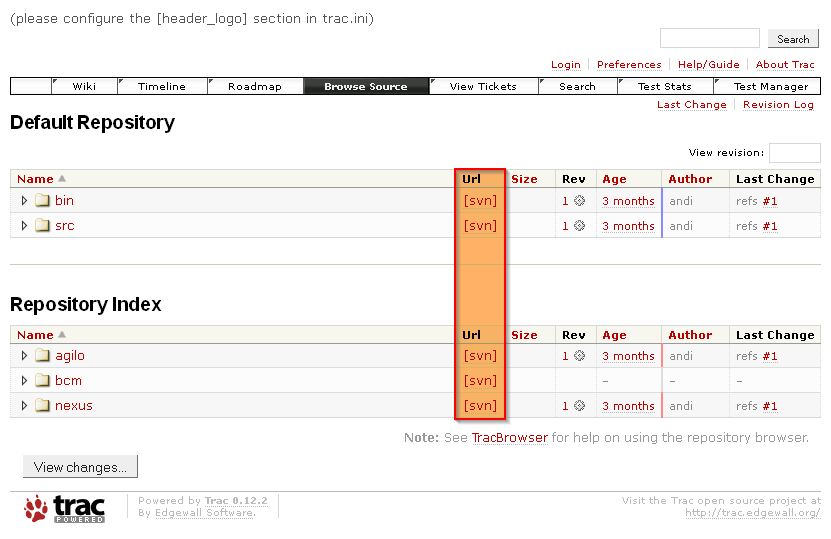

- TRAC CONFIGURE SVN REPOSITORY HOW TO
- TRAC CONFIGURE SVN REPOSITORY INSTALL
- TRAC CONFIGURE SVN REPOSITORY ARCHIVE
- TRAC CONFIGURE SVN REPOSITORY CODE
- TRAC CONFIGURE SVN REPOSITORY PASSWORD
Edit the nf configuration file - below are explained all the configurations.
TRAC CONFIGURE SVN REPOSITORY ARCHIVE
The plugin has a settings file nf that must be configured before deployment. Installation Get a archive with the plugin on your computer from here.

TRAC CONFIGURE SVN REPOSITORY PASSWORD
TRAC CONFIGURE SVN REPOSITORY INSTALL
Sudo aptitude install enscript libapache2-mod-python python-docutils trac db4.3-util libapache2-svn subversion-tools Here are the basic/central steps to take.
TRAC CONFIGURE SVN REPOSITORY CODE
When all this is in place users can take the benefits of using Subversion for version control of the code of the project.Īs of (almost) anything there's also a good howto on the Web for that. In this case a Debian-based OS with an Apache Web server is chosen as infrastructure.Īdditionally a Trac app should be installed which among other things offers nice and convenient Web visualization of the code repository (and its progress) to users. Now, what's up to do is to actually setup a Subversion system on a server and to create a code repository for a programming/development project. There are many tools available to work with Subversion from a client/user perspective like stand-alone client apps, integration in editors, e.g., via special plugins or also complete integration in a full-blown IDE (integrated development environment). Its basic slogan is "CVS done right" (which consequently can be seen as Subversion's indirect predecessor system). This is at the time one of the most popular and up-to-date systems of its kind (i.e., centralized VCS). One such tool is a version control systems (VCS) which basically helps to keep the code and especially its progress under (version) control in a code repository (transparently).Ī specific such VCS is Subversion (a.k.a.
repository aliasTRAC CONFIGURE SVN REPOSITORY HOW TO
So the basic problem here is how to best work together productively in a programming/development project and the question which are good tools providing capabilities to potentially support and improve this. The following trac-admin commands can be used to perform repository operations from the command line.


 0 kommentar(er)
0 kommentar(er)
